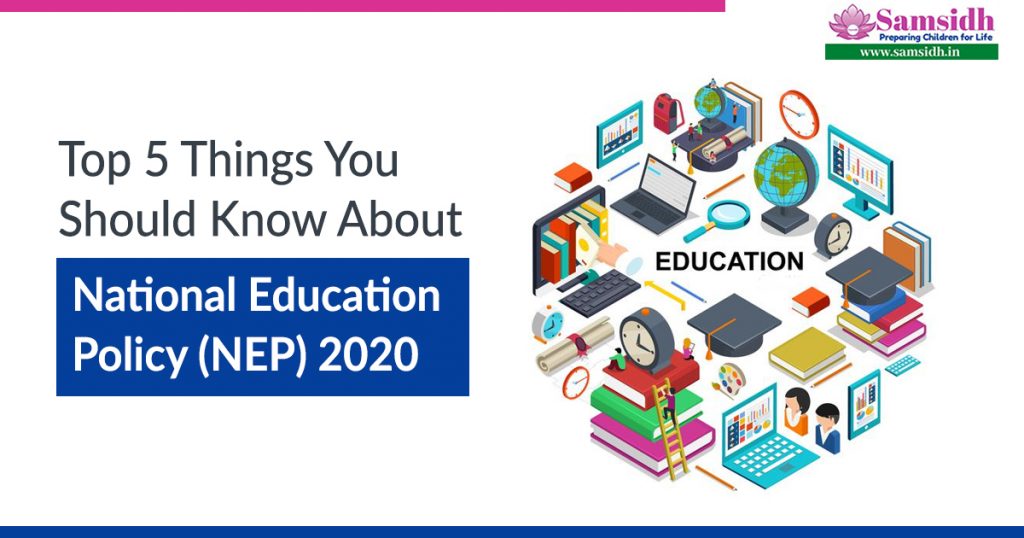
The National Education Policy (NEP) 2020 replaces the 34-year old archaic education system in India through a series of fundamental reforms. The policy brings elementary to higher education under a single umbrella, covering both professional and vocational education. The focus is to foster inquisitive thinking, encourage multidisciplinary education, and imbibe life skills in students that suits present times.
A survey by the National Statistical Office reveals that over 12.6% of students in India drop out of studies. The new policy pledges universal accessibility to education, targeting a Gross Enrolment Rate of 100% in schools by 2030.
Although an ambitious target, if implemented effectively, NEP can take India to the high echelons of global educational competency. The academic experts at Samsidh decipher the key principles that shape up the NEP 2020.
1. New school pedagogy
A progressive pedagogy will replace the existing 10+2 academic structure. This will include 5 years of the foundational stage for ages 3 to 8, followed by 3 years of activity-based preparatory learning for 8 to 11-year-olds. The next 3 years is for experiential learning in middle school for 11 to 14-year-olds. The final 4 years of multidisciplinary study in the secondary stage is for ages 14 to 18 years. The first three years of the foundational stage will be in Anganwadi/ Bal Vatika/ pre-school, while the remaining stages will be in school.
2. Promotion of Regional Languages
To appreciate the linguistic diversity of India, NEP mandates academic delivery to be in mother tongue or regional language, till at least grade 5, and preferably till grade 8. The traditional three-language formula stays, but, NEP promises that no language will be imposed on any student. Indian classical languages like Sanskrit, Tamil, Telugu, Kannada, Malayalam, Odia, Pali, Persian, and Prakrit will be available as a choice while foreign languages like Korean, Japanese, Thai, French, German, Spanish, Portuguese, Russian, will be offered at the secondary level. True to its fair and inclusive principle, NEP pledges to standardize Indian Sign Language (ISL) for the benefit of hearing-impaired students.
3. Multidisciplinary approach
Stereotypical distinctions between academic disciplines, curricular and extracurricular activities will disappear to allow students to choose subjects as per their interests. NEP plans to inject flexibility in the learning pathways, taking a holistic approach in honing the uniqueness of each child and nurturing their talent.
4. Revamped curriculum
NCERT will develop a National Curricular and Pedagogical Framework for Early Childhood Care and Education (NCPFECCE) for children up to 8-years and for students beyond the foundational stage, a holistic National Curricular Framework for School Education (NCFSE). A significant reduction n curriculum load is on the cards, with a focus on essential and experiential learning. States will design their own curricula incorporating the local culture. The availability of textbooks in regional languages will be a priority.
5. Shift to regular, formative assessments
More than rote learning, NEP lays great emphasis on conceptual clarity, critical thinking, and analytical skills. Continuous formative assessments will take place of the traditional summative assessments to promote competency-based learning. Board exams at grades 10 and 12 will test core competencies. Appropriate authority will test students in grades 3, 5, and 8. A 360-degree Holistic Progress Card will be issued to track student progress for achieving specific Learning Outcomes.
A new National Assessment Centre is in the offing as the standard-setting body of all Indian school boards.
Undoubtedly a practical and comprehensive roadmap to revamp the education scenario in India, the success of NEP depends upon the judicious implementation at all levels. Samsidh Group of Schools is in sync with the NEP and has been practicing many of the key NEP principles since its onset.

